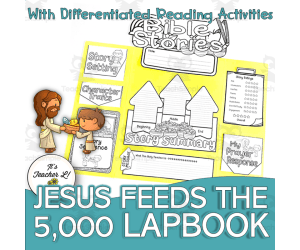2,423 products added recently
Story Template
The Story Template is a helpful tool for guiding students in writing their own stories. This template outlines elements like setting, characters, conflict, climax, and resolution. By providing this framework, students can focus on creativity while maintaining a coherent narrative structure. The Story Template stimulates imagination and makes the writing process more approachable. Use this resource to inspire your students to become confident and expressive writers.
Jesus Feeds the 5,000 Lapbook Grades 4, 5, 6 Bible Story ELA
ELA, Children’s Literature, Literature, Reading Comprehension, Reading, Creative Writing, Writing, Religion, Life Studies, Grade 4, 5, 6, Activities, Projects, Crafts, Centers, Graphic Organizers, Teacher Tools, Templates
Create a purposeful learning experience for your students with this Jesus Feeds the 5,000 Lapbook that they will surely appreciate! This dynamic project is made for Graders 4, 5, 6, homeschoolers, and ESL/EFL learners. Packed with amazing, interactive and differentiated activities and exercises, these lapbook project is perfect for practicing reading comprehension, writing, sequencing, retelling, creative, and self-reflection skills that are suited for your reading class and Sunday school learning. Contents: 6 covers to choose from 2 name pages (individual/group options) 1 inner overlap 2 story summary page options 1 story message page 1 story sequence pocket 6 story sequence photocards 3 story sequence options (easy/average/hard): for reading activities/exercise (6 story sequence cards each option) 6 story retell cards 1 character traits fold 1 story setting fold 1 story ratings page 1 prayer response fold This set can be used as reading class and Bible studies project, supplemental exercises and activities, sub plan and a perfect show piece for Open house events!
Author It's Teacher L
Rating
Tags Jesus Feeds The 5000, Bible Story, Reading Comprehension, Reading Project, Lapbook, Template
Comic Strip Template
ELA, Creative Arts, Art, Writing, Creative Writing, Grade 1, 2, 3, 4, Templates, Teacher Tools
Your students can make their own comic strip with this Comic Strip Template . All you have to do is print and go. There is space for 9 illustrations on this template . Students will love crafting stories and retelling their comic to peers.
Author Elementary Resources 4 U
Tags Comic Strips, Comic Book, Fiction Text, Reading, Comprehension, Story Telling, Crafts, Creative Writing, Reading Centers, Comic Strip Template For Students, Comic Strips Template



